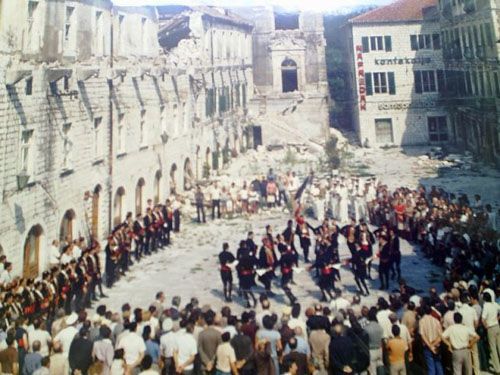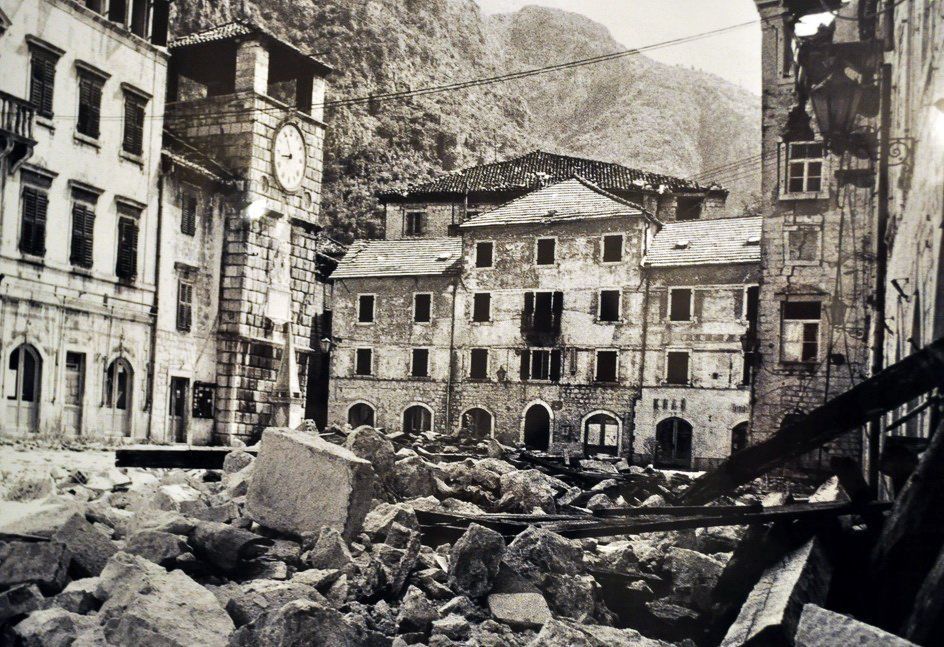April 11, 2019 - The Municipality of Kotor, the Public Institution "Museums" Kotor and the Cultural Center "Nikola Ðurković" will organize a full day program to commemorate forty years since the earthquake (1979-2019) on 15 April.
In the Church of St. Paul, at 9 am, the program will open by the President of the Kotor Municipality, Vladimir Jokić. The audience will also address Bosko Mačić who was the Mayor from 1974 to 1981, and the director of the Public Institution "Museums" of Kotor Dušan Medin.
The exhibition "Listening to the walls that speak" by the author Professor Aleksandar Radojević will be opened by prof. Dr. Ilija Lalošević at 9.20 am.
Entitled "Forty Years Since the Earthquake in Kotor," the round table is scheduled for 10 am. The Boka Navy will play at the Arms Square at noon, at the same place they played after the earthquake 40 years ago, which gave locals some hope and will in the moments of a natural catastrophe.
 Boka Navy Round Dance at the Square of Arms on 15 April 1979
Boka Navy Round Dance at the Square of Arms on 15 April 1979In the church of St. Paul at 4 pm a scientific gathering "Protection of Cultural Heritage of Kotor from the Earthquake to Today" will be organized.
In the Gallery of Solidarity at 7 pm, the Kotor Mayor, Vladimir Jokic will open the exhibition "Kotor from the Earthquake to Today" by our famous photographer, Dr. Stevan Kordić.
In the cinema, "Boka" from 8.30 the film "Recall on April 15, 1979" of RTCG will be shown.
The program is prepared by the Boka Navy, Montenegrin Cultural Heritage Management Board – Kotor Department, Montenegrin Maritime Museum of Kotor, Montenegro's National Archives - Kotor's Historical Archives, Montenegrin Cinematheque, RTCG, Matica Crnogorska - Branch Kotor, Primary and Secondary School for Music Education "Vida Matjan" Kotor, Directorate for Construction Kotor and Public Institution Budva Museums and Galleries.
Kotor and the Area Was Seriously Destroyed in 1979 Earthquake, 136 People Lost Their Lives
The 1979 Montenegro earthquake occurred on 15 April at 06:19 UTC with a magnitude of 6.9 and a maximum Mercalli intensity of X (Extreme). It was the most devastating earthquake on the territory of present-day Montenegro, then part of SFR Yugoslavia. The quake was mostly felt along the Montenegrin and Albanian coastline and followed by more than 90 aftershocks stronger than 4.0 on the Richter scale.
Over 450 villages crumbled to the ground. Also, many communities in the regions of Crmnica, Grbalj, Krajina, and Paštrovići were in danger of near total collapse. Further inland, Cetinje, Danilovgrad, Nikšić and Montenegro's capital city, Titograd (present Podgorica) were damaged as well, but not as severely.
According to a 1984 UNESCO reports, a total of 1,487 objects were damaged, nearly half of which consisted of households and another 40% of churches and other sacred properties. Only 30% of the 1,487 objects damaged were destroyed. Over 1,000 cultural monuments suffered, as well as thousands of works of art and valuable collections.
The epicenter of the devastating earthquake in 1979 was located in the Adriatic Sea, between Ulcinj and Bar, at a distance of 15 km from the coast. In this earthquake, 101 people lost their lives in Montenegro and 35 in Albania. It hit the cities of Ulcinj, Bar, Petrovac, Budva, Tivat, Kotor, Risan and Herceg Novi, and 250 settlements were destroyed. A considerable part of the modern hotel capacities in the region was destroyed, 53 health facilities were been damaged, 570 social and child protection facilities, and 240 school facilities.
 Kotor Immediately After the 1979 Earthquake, Archive Photo
Kotor Immediately After the 1979 Earthquake, Archive PhotoDays after the earthquake, $30,000 was made available immediately for aid work and the restoration of disaster areas. On 28 May 1979, the Director-General of UNESCO issued a worldwide appeal for donations to help the nation recover for the devastation as the federal budget was insufficient for aid funding. Several months later, in October 1979, the World Heritage Committee of UNESCO decided to list the Natural and Culturo-historical Region of Kotor in the World Heritage List and the List of World Heritage in Danger.
The Yugoslav Government agreed to pay 82% of the total estimated cost of damaged cultural property, whereas the remaining 18% was to be paid by the local municipalities. To help meet the total costs of the disaster, the Government had set up a statutory fund whereby each worker across SFR Yugoslavia contributed 1% of his monthly salary towards the restoration effort in ten years, from 1979 to 1989.








